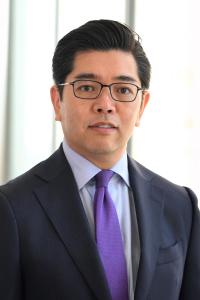ASCO 2025 Roundup
Researchers from Columbia’s Herbert Irving Comprehensive Cancer Center (HICCC) presented key research and insights at the 2025 American Society of Clinical Oncology (ASCO) Annual Meeting, held May 31 – June 3 in Chicago, Illinois. As the world’s leading conference for oncology professionals, more than 40,000 clinicians, researchers, patient advocates, and others attended to share the latest advances in cancer research and care. This year’s theme—“The Art and Science of Cancer Care: From Comfort to Cure”—highlighted the integration of innovation, equity, and patient-centered approaches shaping the future of oncology.

Dawn Hershman delivered the Karnofsky Award lecture address at the 2025 ASCO annual meeting.
A Career of Impact: Dawn Hershman Receives Karnofsky Award
Dawn Hershman, MD, MS, FASCO, was given the prestigious David A. Karnofsky Memorial Award, one of ASCO’s highest honors, which recognized her leadership in cancer care delivery and research. In her lecture, Dr. Hershman highlighted the power of patient-centered research, reflecting on how one patient’s journey sparked questions that drove her research and shaped her career.

2025 Conquer Cancer Young Investigator Award recipients (from left to right): Sunil Bhatt, MD; Abdul-Hamid Bazarbachi, MD; Jacqueline Tao, MD. Photo by © ASCO/Nick Agro 2025.
Select HICCC Research Highlights
Targeting Glioblastoma: Fabio Iwamoto, MD, Presents Phase 2 Lucicebtide Data
Fabio Iwamoto, MD presented updated data from a phase 2 clinical trial of lucicebtide (ST101) in patients with recurrent glioblastoma (GBM). The investigational therapy, developed by Sapience Therapeutics, targets C/EBPβ, a transcription factor implicated in tumor progression and immune suppression. Lucicebtide was well tolerated and demonstrated anti-tumor activity, with 5 out of 9 patients not experiencing disease progression after 10-24+ months.
Biomarker data confirmed that lucicebtide crossed the blood-brain-barrier and induced immune activation in the tumor microenvironment. Additionally, the researchers found this agent shifted glioblastoma cells away from the mesenchymal cell state, which is the more chemoradiation resistant subtype.
Iwamoto expressed optimism that this new drug could offer patients hope where options are currently limited. “I look forward to deepening our understanding of the potential for lucicebtide to improve outcomes,” he says.
Lucicebtide has been granted Fast Track designation for recurrent GBM from the U.S. Food and Drug Administration (U.S. FDA) and orphan designations for glioma from the U.S. FDA and the European Commission.
Promising Advances in Multiple Myeloma: Raj Chakraborty, MD, Shares Early Data from LINKER-MM2 Trial
Rajshekhar Chakraborty, MD, shared early results from the carfilzomib cohort of the LINKER-MM2 trial, which is studying a new drug combination for people with relapsed or hard-to-treat multiple myeloma. In this cohort, the treatment combines linvoseltamab—a type of bispecific antibody that helps the immune system target myeloma cells—with carfilzomib, a drug already used in multiple myeloma.
In the early results, more than 90% of patients responded to the treatment, and 76% had a complete response, meaning no signs of cancer were detected. These responses also lasted over time. The side effects were similar to those of each drug on its own, including things like cytokine release syndrome (an immune reaction), low white blood cell counts, and infections. Because of these promising results, the study is continuing with more patients, and a larger phase 3 trial comparing this approach to standard treatment is planned.


